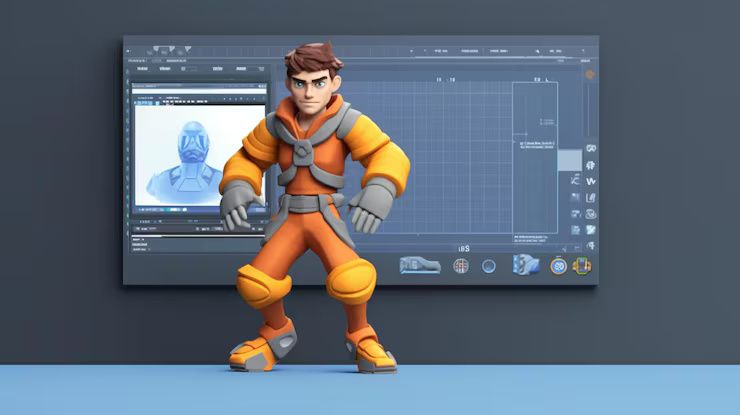3D modeling is the process of creating three-dimensional digital representations of objects, spaces, or characters. Traditionally, designers relied on manual sculpting and advanced design software that required hours of technical effort. Today, artificial intelligence (AI) is changing this landscape.
AI-powered 3D modeling uses machine learning algorithms and neural networks to automate tasks such as mesh generation, texture mapping, rendering, and animation. These tools reduce repetitive work, enhance creativity, and allow professionals to focus more on design rather than technical details.
For example, AI can convert 2D sketches into 3D models within minutes, analyze real-world objects with photogrammetry, or even generate assets for video games and architectural projects. This shift is making 3D design more accessible for beginners and faster for professionals.

Importance – Why AI in 3D Modeling Matters Today
AI in 3D modeling is not just a trend—it’s becoming a vital part of digital design industries. Here’s why it matters:
-
Efficiency: AI reduces manual labor by automating repetitive steps such as rigging, rendering, and surface detailing.
-
Accessibility: Beginners can start creating 3D assets with minimal training, lowering the barrier to entry.
-
Cost Savings: Businesses save time and resources by using AI-driven automation instead of relying entirely on manual design work.
-
Industry Applications: From gaming and animation to architecture, healthcare, fashion, and manufacturing, AI-driven 3D design is widely used.
-
Sustainability: AI tools optimize workflows, reducing unnecessary render times and energy consumption.
Who benefits?
-
Designers and artists who want faster workflows.
-
Game developers looking for realistic and diverse assets.
-
Architects and engineers creating visualizations of buildings and prototypes.
-
E-commerce brands showcasing 3D products for virtual try-ons.
Recent Updates – Trends and Developments in 2024–2025
AI-powered 3D modeling has advanced rapidly over the past two years. Some notable updates include:
-
Generative AI in Design (2024): Platforms like Runway and Kaedim began offering text-to-3D features, where simple text prompts generate 3D models.
-
Real-Time Rendering (2025): More design tools now integrate real-time ray tracing, enhanced with AI, for lifelike visuals.
-
Integration with AR/VR: AI-driven 3D models are being used in immersive experiences such as metaverse projects and virtual reality design.
-
Healthcare Applications: AI-generated anatomical 3D models are improving medical training and patient education.
-
Open-Source Growth: Tools like Blender are expanding AI add-ons, giving independent designers access to advanced modeling without high costs.
Example Data – AI in 3D Design Industry Growth
| Year | Market Size (USD Billion) | Growth Driver |
|---|---|---|
| 2023 | 2.1 | Gaming & E-commerce |
| 2024 | 2.9 | Text-to-3D AI tools |
| 2025 (est.) | 3.8 | AR/VR & Healthcare |
Laws or Policies – Regulations Affecting AI in 3D Modeling
AI-driven 3D modeling is subject to rules around intellectual property (IP), data usage, and digital ethics. Some relevant considerations include:
-
Copyright Laws: AI-generated 3D models raise questions about ownership. In the US and EU, if a model is created entirely by AI, copyright protection may not apply unless there is significant human input.
-
Data Privacy: Tools that scan real-world objects or faces must comply with privacy regulations like GDPR (Europe) and CCPA (California).
-
Industry Standards: In architecture and engineering, AI-based models must meet building codes and safety regulations before being used in real-world projects.
-
Government Support: Countries such as South Korea and Germany are investing in AI-driven creative industries, offering grants and innovation programs to boost design technology.
Tools and Resources – Helpful AI 3D Modeling Platforms
Designers can choose from a wide range of AI-powered software and resources to enhance their creative workflows:
-
Kaedim – Converts 2D images into 3D models quickly.
-
Blender (with AI plugins) – Open-source 3D design software enhanced by machine learning tools.
-
Autodesk Maya + AI integrations – Widely used in film and animation with AI-driven rendering features.
-
Runway ML – Offers text-to-3D generation and creative AI tools.
-
Luma AI – Creates realistic 3D assets from photographs or videos.
-
Adobe Substance 3D – Provides AI-powered material generation for realistic textures.
-
SketchUp with AI extensions – Popular in architecture for creating detailed models with AI-based improvements.
Table – Comparison of Popular AI 3D Modeling Tools
| Tool | Best For | Pricing | Notable Feature |
|---|---|---|---|
| Kaedim | Game asset creation | Paid | 2D to 3D conversion |
| Blender + AI | Open-source flexibility | Free | Large plugin ecosystem |
| Luma AI | Photorealistic assets | Free/Paid | Camera-to-3D modeling |
| Runway ML | Creative AI workflows | Paid | Text-to-3D generation |
FAQs – Common Questions About AI in 3D Modeling
Q1. Can AI fully replace human 3D designers?
No. AI enhances workflows but creativity, storytelling, and artistic decision-making still require human input.
Q2. What skills should designers learn if AI automates modeling?
Designers should focus on creativity, design principles, storytelling, and mastering AI tools as assistants rather than replacements.
Q3. Are AI-generated 3D models legal to sell?
Yes, but designers must ensure compliance with copyright laws and avoid using copyrighted training data without licenses.
Q4. Can beginners use AI-powered 3D tools?
Yes. Many tools are designed for accessibility, allowing users to create models with little prior technical experience.
Q5. What industries are adopting AI in 3D modeling the fastest?
Gaming, architecture, animation, e-commerce, and healthcare are among the top adopters.
Final Thoughts
AI-powered 3D modeling is reshaping how designers approach creativity. By reducing technical barriers and automating complex tasks, AI allows professionals and beginners alike to focus on artistic vision. While it introduces questions around copyright and data ethics, its potential in industries from gaming to healthcare is enormous.
Designers who adopt AI tools early will likely gain a competitive advantage, not by replacing their creativity, but by enhancing it with smarter workflows.
